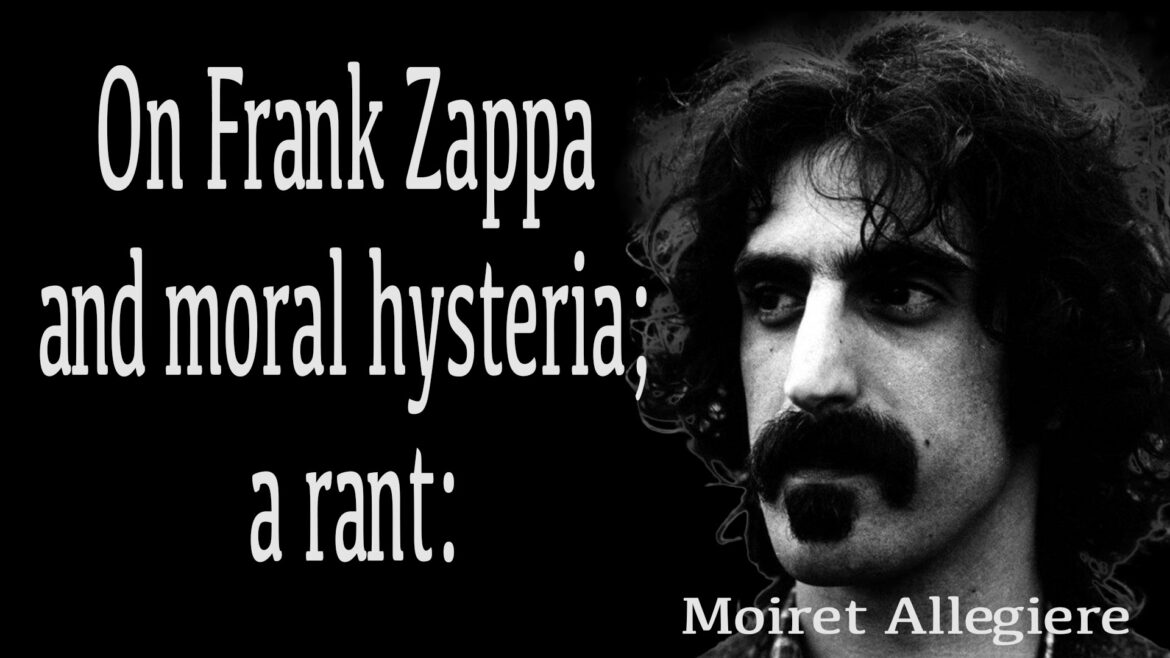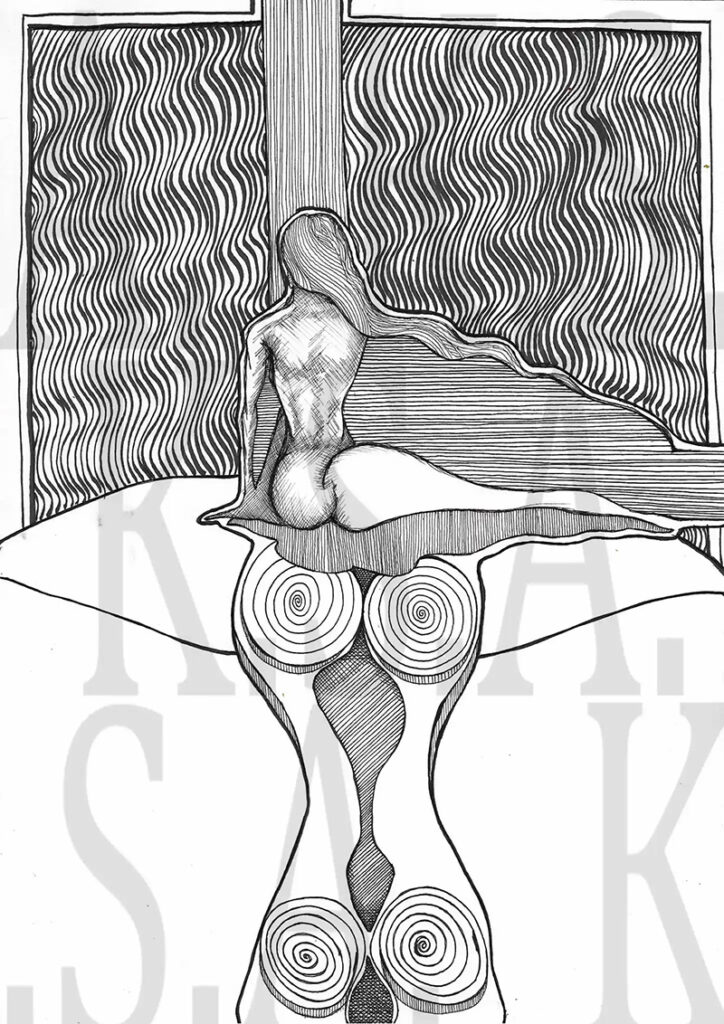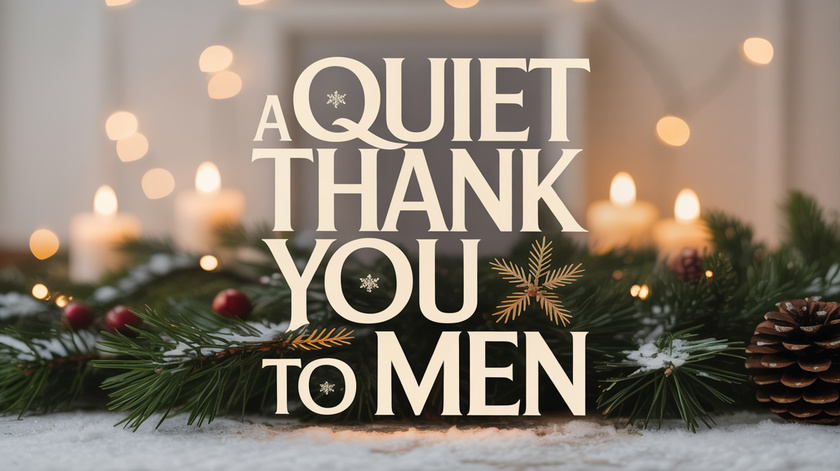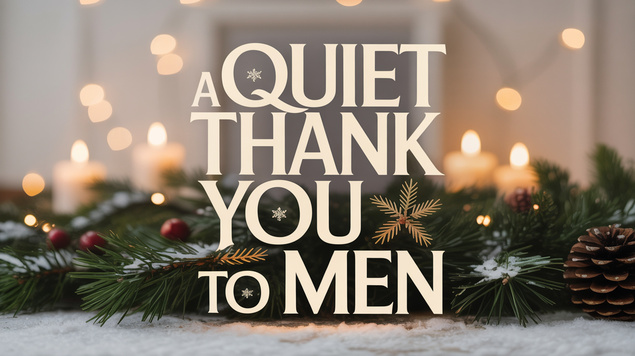On Frank Zappa and moral hysteria; a rant:


Back in the 1970’s, the phenomenal musician (and professional grumpy bastard), Frank Zappa, was asked a fairly simple question.
Not only was it a simple question; it was one of such monumental stupidity and entitlement that it could only ever have come from the quivering lips of a ferocious feminist scorned: why was this terrible misogynistic male so mean to women in his lyrics?
Now, anyone who has spent any amount of time listening to Frank Zappa will have noticed a few things about his music, his lyrics and – perhaps – the man himself;
1: he was god-damned brilliant. I would dare say he was a genius, though I admit to being a drooling fanboy of his, and as such very biased in his favour. I even named my first dog after him. (She is a bitch, and a tiny chihuahua. Somehow, it seemed rather fitting.)
2: His lyrics kick in all directions. Nothing is ever sacred and absolutely no-one is safe. He himself stated that “Yes – my lyrics are stupid. So what?”
In the musical world of Frank Zappa, lyrics was a necessary evil – a thing that had to be present in music in order for the music to sell, as so very few people listen solely to instrumental music. They were, in fact, nothing but a means to an end. Thus, silly, absurd and comedic lyrics became his thing. Because why the hell not?
In reply to the question, he answered that women need to learn how to take their lumps, same as men.
And this is absolutely true.
There is the thing of it, I think: feminism may very well preach equality – women in general may very well preach equality; may claim to very much be in favour of equal treatment of the sexes, thank you very much, it is the current year, after all.
Yet what is said and what is done are two quite different things. I believe a thing people have to learn as quickly as possible is that people’s words and people’s actions are quite often not the same. Quite the contrary. They clash and they crash very often. Human beings are complex and intricate creatures, filled with internal contradictions and inconsistencies. This is just part of human nature, I suppose.
It is not always easy to practice what one preaches, though I would sorely wish to see more people do so. This, however, requires a lot of introspection and “soul-searching”. This seems to be rather difficult at the present moment, as narcissism is on the rise and everything is always someone else’s fault. As is so often the case, people are not even aware of their failure to walk the talk, to practice what they preach. Particularly so when feminism has tricked the entirety of the western world into believing that men treat other men with all manner of respect and adoration; with all manner of underhanded deals and preferential treatment and what-have- you’s which they do not grant to women.
This is, as I have come to understand it, psychological projection on part of women in general, and within feminism specifically. They would treat other women preferentially: their in-group bias is way stronger than that of men. So, to their eyes – being unable as all hell to tear their gaze away from their navel – there is no reason why men would behave differently. “We would do this, and so they must also do this”. Add some solipsism into the mix, and you have yourself a cake not fit for human consumption. In fact, it is a cake which they both want to have and to eat.
The fact that Frank Zappa poked fun at men in his lyrics – quite often, and in quite fabulous ways – was forgotten by the feminist scorned, who only noticed women being poked fun at. One assumes that she was quite alright with poking fun at men in general. One also assumes that she did not notice that men were poked fun at because that was a message she agreed with; that this was something inherent to her view of the world and as such was a statement of fact, not a matter of men being ridiculed.
If people were to open their eyes… if people were able to remove their gynocentric blindfolds and see the world proper, the first thing to be noticed would perhaps be a certain elevation – one could almost say deification – of women and of womanhood. Women being sat atop a throne made from delicate and fragile flowers; a throne that would topple and crumble to dust at the slightest breeze. It is not rare to see women – whether blatantly feminist or not – go up in arms at the slightest hint of a joke being cracked at the expense of women, claiming this to be proof definitive of a society that just hates women ever so much, dont’cha’know and so we must have all of this and all of the other to lift women up in this society in which women are hated so much that they get all this preferential treatment… as well as a movement supposedly only for them; a movement that shall hold the monopoly on all things sex and gender; a movement which one must have balls of polished nuclear warheads to dare defy, under pain of social ridicule and death.
Women are hated, so a movement solely for women gets all the say and holds all the sway on all the things.
Makes perfect sense, of course.
And I am the emperor of Norway, keeper of the seven keys and dictator for life in the tiny island nation of Hwat Teh Fcuk.
Poking fun at typical female idiosyncrasies, at female stereotypical behaviour is a big fat no-no, and all who commit this most heinous act are misogynistic poopy-heads whose mother was a hamster and whose father smelled of elderberries. And the feminist hordes will fart in their general direction. All the while saying that we should kill all men and stating with absolute certainty that men, that masculinity, that maleness and whatever else is all that is wrong with the world; that all men must take responsibility for the evil of one man, and so forth and so on. And one can not help but wonder: if merely cracking jokes at the expense of women in general is proof of a society that hates women – what does it say about a society in which it is quite alright for academes to publish deathly serious articles titled “why can’t we hate men”? What does it say about a society in which this article is not only alright to publish, but where the author of said article is being presented as a victim for facing backlash to her blatant hatred of the male sex? A society that hates women and adores men would surely not present a woman that shamelessly presents her hatred of men as a victim of men when men – quite rightfully – react to being hated for nothing but them being men.
Jokes perpetuate negative stereotypes of women, and furthers the oppression of women.
Articles justifying hatred of men – published in mainstream media – is proof that women are hated. I will keep repeating these points until people fucking listen. Repeat, repeat, repeat.
The whole world has gone insane. Completely and utterly insane, locked within a moral hysteria built upon vapid moral grandstanding and virtue-signaling by power-hungry navel-gazers whose values are just as deep and firmly anchored as a loosely knit fart.
Ah, shit, this nonsense is trendy now.
Gotta hop along; social validation is the most important thing in the world, after all.
#MenAreTrash! Am I right, sisters? Now – let me get a crack at that pussy. Shit: men may be trash. But I am the exception to the rule. I consider all other men to be trash because I believe them to think and act exactly like me. Now, let me get a crack at that crack. Maybe some good old fashioned simpering, whimpering and puppy-eyed begging will make it so that she touches my penis….Please touch my penis!
#CancelMen, for fuck sake. What does a brother have to do in order to get laid around here? I’ve been self-flagellating for hours on end, but they’ve only been spitting in my eyes. And I am an ally to the noble cause, for Goddess’ sake. Still permanently othered, of course, being but an ally… but I am an ally to the cause of pussy- power. Even wore the pink pussy-hat, for fuck sake.
Please touch my penis.
Ahem.
Carrying on:
Poking fun at typical male idiosyncrasies – at male stereotypical behaviour – is quite alright. This happens every single day, every which where one should so happen to look. And I am perfectly fine with this, without a doubt. The ability to laugh at oneself is a transformative tool. Empowering, if I may be so bold as to borrow a buzzing phrase from the feminist handbook.
People would do well to not take themselves so damned seriouslyall the time.
What is bothering, on the other hand, is the feminist hive-mind having fits of hysteria whenever a woman is poked fun at. What is bothering is – as is so often the case – the blatant double-standard of the thing; the hypocrisy, the idiocy of it all. Add to this the inability of people to see this for what it is: anything but equal treatment. Can’t see the forest for a bunch of pretty little lies and liars squinting at the sun as it pisses in their eyes. Treating the sexes equally does not mean that women should be a protected class of people, never to be made subject to the same mockery and ridicule that men are made subject to.
Just take a look at your average sit-com for examples of this. Or talkshows… day-time television in general, for that matter. Men are bumbling fools, not elevated moral guardians such as women are.
This notion that preferential treatment of women equals equal treatment of the sexes ties very nicely and neatly into a study done by one Amy Yeung (https://uwspace.uwaterloo.ca/handle/10012/6958 ), in which it is revealed that women consider it to be sexist when men treat women worse than they would treat other men, that women consider it sexist when men treat women just as they would treat other men… considering it only to be equal treatment when men treat women better than they would treat men.
I find this very interesting, as it explains the squeaks, squawks, cuckoos and cackles, moans, marbles, howls and rise of feminism in no small way. It explains perfectly well how a movement can push for preferential treatment and label this as equal treatment. Women view preferential treatment of women to be equal treatment of women. So-called “benevolent sexism” is still detrimental to women, of course. Because what isn’t? Yet they push for it. Who can fathom the feminine mind? Not my wife, that’s for damned sure. By her own admission.
It’s OK, brothers – my wife is an honorary man; a de facto member of the Patriarchy. Our greatest secretary and coffee fetcher, in fact.
Oh boy, I’m going to the special feminist circle of hell for that one.
Not that I believe feminism, or most women, really, able to see this for what it is. I don’t believe most men are willing to see this for what it is either. For women are precious, and must be protected and one can not make fun of women for exactly that reason.
Besides, it supposedly lowers ones chances of getting laid, and men have drives, desires and needs, god-dammit(!) Dick Hardy is a most potent negotiator. Too bad he is fucking brain-dead.
No matter, never mind.
She Said! He said! Chivalry is far from dead!
And if chivalry is dying; if men treat women equally… if men treat women like they would treat other men, articles start popping up from wherever and whatever mourning the death of chivalry and oh and woe-is-me, but where oh where have all the good men gone?
Of course men should pay on dates – women deserve to be taken care of and feel special. But the relationship has to be equal; step up, men, and do your part of everything… whilst paying for everything.
What, women doing their part? Nah, that is just some patriarchal entitlement – yet another unreasonable expectation of women… male entitlement to this and that and the other, as a matter of fact.
Fuck you. Suck my balopticon.
Men should not enjoy their women having an orgasm – that is peak male entitlement right there. Imagine finding enjoyment in ones partner being given enjoyment by oneself. Shock and horror!
Still: women should damned well have at least one orgasm for every ride into funky-town, thank you very much. Just don’t enjoy it while you’re at it, boy. No-one cares if your jaw is frozen solid and your hand is cramping up; get to it, buddy!
What; you want pointers?
Nah, man, you’ve got to know your way around a woman’s body by instinct and intuition alone… Imagine the entitlement in wanting a woman to tell you what she enjoys and how to do it proper… the pure nerve of expecting a woman do something in the sack – goodness gracious, what prime male entitlement this is! Also – fleshlights and sexbots are objectifying women and mass-manufacturing rapists, and so to do porn and masturbation is akin to cheating and, hey, where are you going? Oh, my, why can’t I ever find a good and decent man?
People in glass-houses can not smell their own shit. Instead of listening to what is being said when feminism – when this entitled behaviour – is criticised, they jump into the very same aforementioned hysterics, put words in your mouth and pull strawmen out of their own arse to set on fire. Screaming that women are not hysterical, but perfectly rational and capable of reasonable discussion, fuck you very much and besides, you make her feel threatened and unsafe by your mere presence, fuck-face.
Add a solitary screech about “PATRIARCHY!!?!!?!?!!!” in there, and we have ourselves a winner, ladies and germs. Men have to accept jokes made at the expense of men in general. Televised stereotypes of men? Ain’t nothing wrong with that. To which I would agree, in all honesty. Reverse the sexes, and the shit-show begins. Apparently, men are capable of humour and of laughing at themselves, whereas women are not. Is it masculinity that is fragile, then, or is it perhaps femininity?
#FemininitySoFragile.
Back in my facebook-days, I was part of a Facebook-group that focused on record-collecting and HiFi equipment. As one would expect, men being far more object-oriented than women, this group was overwhelmingly male. I would hazard a guess at it being 98 percent male.
The discussions on records, music and equipment went as one would expect. Typical male banter; friendly insults and the like.
“What the hell kind of piece of shit equipment is that to play that record on? This record deserves tubes blown by the exotic virgins of lala-land and gold-plated cables, handspun by the queen of England, for fuck sake – bunch of amateurs in here.”
You know what kind of friendly banter I am referring to. All in good fun.
And it was good fun, while it lasted.
For, you see, the feminists entered the room; probably smelling a predominantly male space populated by horrible men in dire need of being civilised by the elevated morals of womanhood; a goddess in the guise of feminism come to save these barbarian men from themselves. Come to make sure the good ol’ boys don’t have too much unsupervised fun.
Though I can not prove this, I will dare state that the sole reason for these two feminists being in this group was tone-policing and feminist propaganda, as the only damned thing they posted in there had to do with women and with feminism.
Even when posting pictures of their records or whatever, they always included some fucking feminist “factoid” alongside the picture. Seemed rather planned, if I am to be perfectly honest.
Every day with that shit; feminism me here and pay-gap me there and horrible titties on the covers or on posters on people’s wall over there, making it such an unsafe and non-inclusive group for the women in the group and no wonder there were so few women there and so-and-such and blah-di-blah and shame the male for he is a true bastard-barbarian. How fucking entitled does one have to be to demand people remove posters that are deemed offensive by fragile feminists from their own walls in their own bloody homes? Feminist-levels of entitlement. And fragility.
#FemininitySoFragile
Whenever a woman enters a predominantly male space, it is expected that the men therein shall alter their behaviour so as to not offend her. It does not matter how many men there are in the space or in the group: the word of this one woman has to be law. And, by damn and fuck-me-right-in-the-back-ear: men agree and comply and alter their behaviour to suit the woman, for some ridiculous reason. Female entitlement is enforced by men. There is no denying this. You are allowed to say no to women, you know. Even Dick Hardy is allowed to do just that. In fact, Dick hardy must be encouraged to do just that. So much of this god-damned shit is on our shoulders, gentlemen. You don’t have to put up with it, you know.
So I left this group. After about a week of seeing these two women – might have been one woman with two accounts, come to think of it – constantly posting feminist nonsense, I had just about had it. Then I reached my tipping point, the scales were waxed and the shit slid off and hit the fan, spreading it way more than anyone should accept.
One dude in the group had the nerve, you see, had the unmitigated audacity to refer to Yoko Ono as “the bitch that ruined the Beatles”.
Oh boy.
Oh my.
Oh girl.
Oh fragile femininity supreme.
What a shit-show that turned out to be; a macabre and grotesque cabaret. The feminist footsoldiers came rolling in, floating on the wind by virtue of their bingowings, frothing at the mouth, spittle flying every-which-where, demanding the post be removed, claiming that this group was nothing but a bunch of misogynists; a sorry nest of gender-fascists, in fact.
Yes.
They actually used the term “gender-fascists”.
This, then, was the moment they had been waiting for. Finally, they could spring into action on behalf of scorned women everywhere; women who have to put up with female artists being disliked like male artists are disliked. What horror was this?
Irrational emotionally laden screeching followed. A woman can not be criticised. Not even a female artist. One has to worship the ground she walks on. Any one man can not have any one individual opinion on any one woman; neither the woman nor her caterwauling – that is to say, her art – may be subject to criticism. For any critique of a woman, or her art, necessarily must mean that one hates all women by virtue of their sex. And this has to reflect on the entirety of the group, for men – as we all well know – are a homogeneous blob; a mass of testosterone and brawn and perfectly erect penises that have neither solitary opinions nor individual personalities.
And so many guys in that group simpered and drooled and fell to their knees in abject shock and horror; apologizing profoundly and profusely on behalf of the group. A few brave men dared defy the feminine deity that had entered the space; but the damage was done, the battle was won and the female tyranny reigned supreme that day. All the men had learned of their folly and been given a whipping for their insolence in talking back to their superiors.
Earlier that day, I had posted a picture of Warren Zevon’s phenomenal album “the Wind”. I referred to Warren Zevon as a complete and utter arsehole; a narcissistic bastard with no redeeming qualities except his incredible musical and lyrical talent. He was then, and remains still, one of my favourites. Quite possibly the greatest songwriter to have ever graced this green earth. Second only to Townes van Zandt. Other guys in the group agreed. Other guys in the group had posted similar things about other male
musicians.
No-one reacted with anger or hostility, or claimed that we were just hating on men for them being men. Not even the feminists in the group.
Imagine my shock.
Criticising a female artist, on the other hand, means that the entirety of the group hates women.
Women in male spaces can not help but destroy the male spaces, it seems. Helped very much by the simpering men therein. Much like Yoko Ono, in fact. Women really need to learn how to take their lumps, how to take criticism. Women need to learn that criticism of one woman does not equate to hatred of all women everywhere.
… Much like Yoko Ono, in fact.
Moiret Allegiere (Born 1986) hails from Norway. A self-described scribbler of lines, juggler of words and weird pseudo-hermit, he became so concerned with the state of the world that he left his long and deliberate hibernation to wreak bloody havoc on the world of fine art and literature.

















